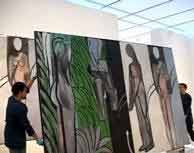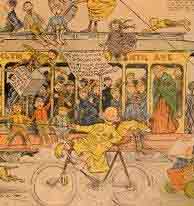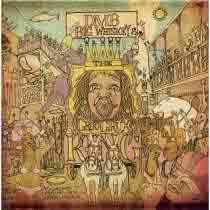Also: A question from China about the term ''yellow journalism.'' And new music by the Dave Matthews Band.
HOST:
Welcome to AMERICAN MOSAIC in VOA Special English.
(MUSIC)
I'm Mario Ritter.
This week on our program, we play some new music from the Dave Matthews Band ...
And answer a question about the term “yellow journalism” ...
But first, we report on a Web site for art lovers.
(MUSIC)
ArtBabble
HOST:
ArtBabble.org is a Web site filled with hundreds of videos about art, artists and museums. It permits viewers to experience the life of museums in many different forms. Museums and galleries from around the United States have placed their videos on this Web site to help connect viewers with the world of art. Barbara Klein has more.
JACOB LAWRENCE: "If everything was stripped away from me, and I had no other support that I could see or appreciate, I would still paint. I would still be doing that."
BARBARA KLEIN:
That was a video about the African-American artist Jacob Lawrence made by the Los Angeles County Museum of Art.
It is one of many videos on ArtBabble. As you watch a video on this Web site, a list of other videos appears nearby. The list is a suggestion of videos related to the one you are watching.
ArtBabble describes itself as a place where everyone is invited to join the discussion. You do not have to have a college degree in art. ArtBabble was created by the Indianapolis Museum of Art in Indiana. This museum invited other art organizations to add videos to the site. They include the New York Public Library, the Smithsonian American Art Museum in Washington, D.C., and the San Francisco Museum of Modern Art. Until now, you could see art videos on museums’ Web sites or on YouTube. But there was no Web site that was only about art videos.
You can see videos about modern artists like Jenny Holzer.
JENNY HOLZER: "My work might be like theater in that I hope there’s an audience. There’s a reason I’m anonymous in my work. I like to be absolutely out of view and out of earshot."

Or you can see how experts place art in a museum exhibit.
(SOUND)
One video by the Art Institute of Chicago shows a group of workers very carefully moving and hanging a huge painting by the French artist Henri Matisse.
Another shows a museum guard answering the hundreds of questions he receives every day from visitors. One page of the Web site lists videos by subject. They include Chinese, art, graphic design, sculpture and photography.
One expert at the Art Institute of Chicago described ArtBabble as a giant leap forward for museums and for Web users. He said it offers a modern new way to share high quality videos with a large group of people interested in art.
(MUSIC)
Yellow Journalism
HOST:
Our listener question this week comes from Jenny Meng in China. She wants to know the meaning of the term "yellow journalism."
The terms "yellow journalism" and "yellow press" are not used much anymore.
They mean a kind of news reporting that uses an emotional style and personal opinion. Yellow newspapers also used a lot of pictures and included things like reduced price coupons for theater and rail tickets. There also were games, prize puzzles and lots of advertisements.
Sometimes, yellow newspapers would also make up exciting news stories and false interviews to increase sales.
The term yellow journalism started in the late 1890s. A fierce media war was going on between two major newspaper publishers in New York. One was Joseph Pulitzer who owned the New York World. The other, William Randolph Hearst, owned the New York Journal.

Joseph Pulitzer’s paper had a longer history than Mr. Hearst’s. William Randolph Hearst wanted his newspaper to be as popular. He began to take reporters and editors from the New York World to work for his paper. Mr. Hearst also took a cartoonist from Mr. Pulitzer’s paper. R.F. Outcault drew "Hogan’s Alley," a well loved cartoon with a character dressed in yellow and called “the yellow kid.”
Joseph Pulitzer hired another cartoonist and told him to begin drawing another yellow kid. The media war between Hearst and Pulitzer became a fight between the "yellow kids." As a result, that style of news reporting came to be called yellow journalism. Historians say the yellow press was so powerful it helped push the United States into war with Spain in 1898.
W. Joseph Campbell is a communications professor at American University in Washington, D.C. He has written four books about journalism, including "Yellow Journalism: Puncturing the Myths, Defining the Legacies." Mr. Campbell writes that William Randolph Hearst did not think that reporters should be neutral. He believed in a so-called journalism of action. The publisher thought the press had a duty to place itself into stories to right wrongs where it could.
Mr. Campbell says the most dramatic example of this was the freeing of a Cuban political prisoner. Mr. Hearst sent a reporter to Cuba in 1897 to secretly rescue 19-year-old Evangelina Cisneros from a prison in Havana. The plan worked and it was big news for the New York Journal.
(MUSIC)
Dave Matthews Band
HOST:

The Dave Matthews Band returns with their first CD since the death of band member LeRoi Moore. The saxophonist died a year ago in a vehicle accident at the age of 46. LeRoi Moore was one of the founding members of the band. The new CD, "Big Whiskey and the GrooGrux King," is named in his honor. And it opens with the sound of his sax. June Simms has more.
(MUSIC)
JUNE SIMMS:
"Grux" is the opening track on the Dave Matthews Band’s new CD. It is the band’s seventh studio album and the first without LeRoi Moore whom they called "GrooGrux King." He took part in the early recording sessions for the album. But, most of the album was recorded after his death.
The South African born Dave Mattews is the driving force behind the band. Carter Beauford plays drums. Stefan Lessard plays bass. Boyd Tinsley plays the violin. Matthews put all the pieces of the band together like a well designed puzzle. Now with LeRoi Moore gone, a piece of the puzzle is missing.
Moore’s sax work can be heard on this song, "Lying in the Hands of God."
(MUSIC)
"Big Whiskey and the GrooGrux King" is the band’s fifth album to enter the Billboard Magazine’s album chart at number one. Dave Matthews told Billboard that if this is the last album he ever makes, he hopes it is the only album that people listen to.
We leave you with the album’s first single, "Funny the Way It Is."
(MUSIC)
HOST:
I'm Mario Ritter. I hope you enjoyed our program.
It was written by Dana Demange, June Simms and Caty Weaver, who was also our producer. For transcripts, MP3s and podcasts of our programs, go to voaspecialenglish.com. You can also comment on our programs and send us questions.
Join us again next week for AMERICAN MOSAIC, VOA’s radio magazine in Special English.
earshot: the range within which sound can be heard by the unaided ear; hearing distance 聽力所及之范圍
graphic design: the practice or profession of designing print or electronic forms of visual information 平面造型設計
Related stories:
Rocking out at the air guitar championships
A colorful exhibit tells about Amish traditions
You can see street art for free around the world
Two art exhibits in Washington
(Source: VOA 英語點津編輯)